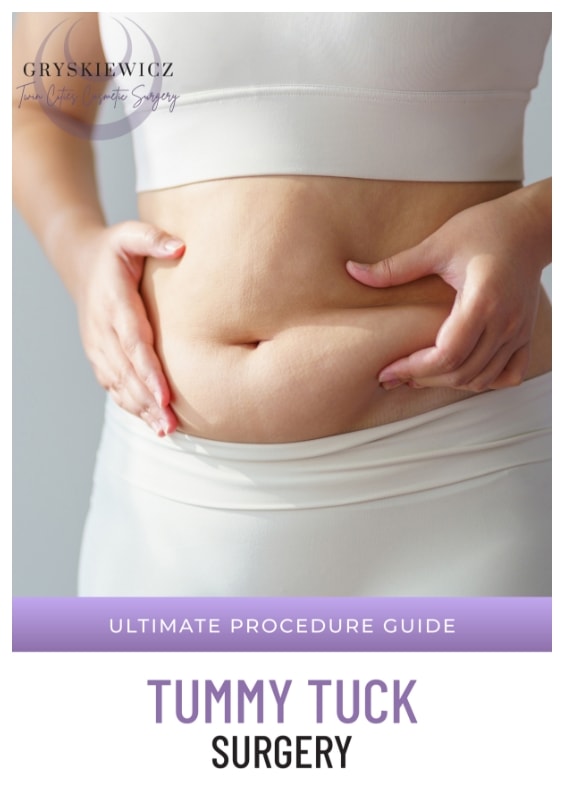How to Treat Your Tummy Tuck Scar to Get Better Results
Effective Tips for Caring for Your Tummy Tuck Scar
A tummy tuck (or abdominoplasty) typically leaves a scar running along the lower abdomen, just above the pubic area, and sometimes around the belly button. Your plastic surgeon aims to place this scar where it can be hidden by underwear or swimwear. It might start as red or pink and gradually fade over time, but the way you care for it can make a big difference in its appearance.
Dr. Joe Gryskiewicz, a highly respected, board-certified Minneapolis plastic surgeon with over 35 years of experience, specializes in cosmetic procedures, including tummy tuck surgery.
Are There Different Types of Tummy Tuck Scars?
Yes, there are different types of tummy tuck scars, and the type you end up with depends on the specific procedure you undergo and your body’s healing process. Here’s a look at the most common types:
Full Tummy Tuck Scar
A full tummy tuck (traditional abdominoplasty) usually leaves a scar that runs horizontally across the lower abdomen, from hip to hip. Dr. Joe aims to position it low enough so that it’s easily hidden by underwear or swimwear. This type of scar is the most common and is necessary to remove excess skin and tighten the abdominal muscles.
Sometimes, a full tummy tuck also involves repositioning the belly button, resulting in a small circular scar around it. Dr. Joe tries to minimize its visibility by placing it discreetly within the natural contours of the skin.
Mini Tummy Tuck Scar
A mini tummy tuck, as the name suggests, is a less extensive version of a full tummy tuck. This procedure focuses on the lower part of the abdomen, below the belly button. The scar is shorter, usually located just above the pubic area, and may not extend as far as a full tummy tuck scar. This option is often for those with less skin laxity or fat below the navel.
Since the incision is smaller, recovery time may be shorter, and the scar might be easier to hide. However, a mini tummy tuck may not provide the same level of abdominal muscle tightening as a full tummy tuck.
Fleur-de-Lis Tummy Tuck Scar
A fleur-de-lis tummy tuck is a specialized technique for those who have a significant amount of loose skin both horizontally and vertically (such as after bariatric surgery or extreme weight loss). This body plastic surgery procedure results in both a horizontal scar (similar to a full tummy tuck scar) and a vertical scar that runs from the lower part of the abdomen up toward the breastbone.
While this type of scar is more extensive and visible, it’s necessary for patients who need more comprehensive skin removal and contouring.
Regardless of the scar type, proper post-operative care and treatment options can help minimize its appearance over time.
Early Scar Care – The First Few Weeks
Right after your tummy tuck, your main focus should be on keeping the incision clean and protected. This stage sets the foundation for how the scar will heal in the long run. Here’s what you can do:
- Keep the Area Clean and Dry: Follow Dr. Joe’s instructions about washing the area. Gentle cleaning with mild soap and water, once permitted, can help prevent infection, which is crucial for a smooth healing process.
- Use Prescribed Ointments: Dr. Joe might recommend an antibiotic ointment or silicone gel to keep the area moist and help with healing. These can act as a barrier and promote smoother skin as the scar forms.
- Avoid Strain on the Area: Limit movements that might stretch the scar. For the first few weeks, avoid bending, lifting, or activities that put pressure on your abdomen.
Protecting Your Scar from the Sun
Sun protection is a key part of keeping your scar as discreet as possible. Scars exposed to the sun can darken and become more noticeable, especially in the early stages of healing.
- Use Sunscreen: Once your scar is fully closed, applying sunscreen (at least SPF 30) can help protect the area from darkening. Look for a sunscreen that’s gentle and safe for sensitive or healing skin.
- Cover Up: If possible, wear clothing or use a bandage to cover the scar when you’re out in the sun, especially in the first year. This gives an extra layer of protection.
Massaging Your Scar
Gentle massage can be helpful once the incision has healed enough that Dr. Joe gives you the green light. This can improve blood flow and help break down the tissue that can lead to raised scars.
- How to Massage: Use gentle, circular motions around the scar area. You can also move along the length of the scar, applying light pressure with your fingers.
- Frequency: Aim to do this for a few minutes each day. Consistency is more important than the intensity of the massage, so keep it gentle.
Scar Creams and Silicone Sheets
Once your scar has healed over and you’re no longer at risk for infection, you might want to explore scar treatments. Silicone sheets and scar creams are popular options.
- Silicone Sheets: These are adhesive sheets that you place over your scar. They help keep the skin hydrated and compress the scar, which can make it look flatter and less noticeable over time.
- Scar Creams: Look for creams that contain ingredients like silicone or vitamin E. These can be soothing and may help improve the scar’s appearance.
Staying Hydrated and Nourished
Taking care of your body from the inside out can also play a role in how well your scar heals. Staying hydrated and eating a balanced diet with plenty of protein, vitamins, and minerals supports skin health and tissue repair. Focus on foods rich in vitamins C and E, which are known for their benefits in skin healing.
Avoiding Smoking
If you smoke, it’s especially important to avoid smoking during your recovery. Smoking can slow down healing and negatively affect blood flow, which may make your scar appear more prominent. If you’re having trouble quitting, talk to your doctor for support.
Avoid Heavy Lifting
Lifting heavy objects can put strain on the abdominal muscles and the healing tissues, causing the scar to stretch, widen, or even reopen. During the first 6-8 weeks post-surgery, it’s important to refrain from lifting anything over 10-15 pounds. This includes everyday tasks like carrying groceries. Instead, focus on using proper lifting techniques—bending at the knees rather than the waist—to reduce strain. Gradually easing back into heavier activities, only after Dr. Joe has given the go-ahead, helps ensure that the scar stays flat and heals well over time
Wearing Compression Garments
It’s natural to want your scar to fade quickly, but it’s important to be patient. Scars take time to mature, and the process can vary for each person. Over the months following your surgery, you might notice the scar becoming lighter and softer. Remember, it can take up to a year or more for a scar to fully settle.
Dr. Joe recommends wearing a compression garment after a tummy tuck. This isn’t just for shaping purposes—it also supports the healing process. These garments provide gentle pressure, which can minimize swelling and help the scar stay flat as it heals.
Laser Treatments and Other Professional Options
If you’re looking for additional ways to minimize the appearance of your scar, there are a range of professional scar treatments available from our team:
- Laser Therapy: This option targets the pigment in the scar, helping to lighten it. Laser resurfacing treatments can also improve texture, making the scar feel smoother. Make sure to consult with Dr. Joe to see if this is right for you and to determine the best timing for this type of treatment.
- Microneedling: SkinPen® microneedling involves tiny needles that create micro-injuries in the skin, encouraging collagen production. When performed by a professional, it can help soften and flatten scars.
- Steroid Injections: For thicker or raised scars (like hypertrophic scars), steroid injections can reduce inflammation and flatten the scar over time.
When to Seek Help for Your Tummy Tuck Scar
While it’s normal for scars to change as they heal, there are a few situations where it’s important to consult Dr. Joe:
- Raised or Thickened Scar: If your scar becomes raised or feels thick, it could be developing into a keloid or hypertrophic scar. Early treatment options, like steroid injections or silicone sheets, can help manage this.
- Scar Darkening: Some darkening can occur, but if your scar is becoming significantly darker, especially with sun exposure, professional treatments may be needed.
Tummy Tuck Scars FAQs
How long does it take for a tummy tuck scar to fully heal?
The full healing process for a tummy tuck scar can take up to 12 to 18 months. Initially, the scar will be more noticeable, appearing red or pink for the first few months. Over time, it will gradually fade and flatten, though it may never completely disappear. Factors like your skin type, genetics, and how well you care for the scar can influence the healing time and the final appearance.
Can I use over-the-counter scar creams on my tummy tuck scar?
Yes, over-the-counter scar creams can be helpful, but it’s essential to follow Dr. Joe’s recommendations on when to start using them. Many creams contain ingredients like silicone or vitamin E, which can improve the texture and appearance of scars. However, it’s important not to apply any products until your incision has fully healed and your surgeon has cleared you for topical treatments.
Will my tummy tuck scar stretch over time?
In some cases, tummy tuck scars can stretch slightly over time, especially if there is weight fluctuation or significant strain on the abdominal area. Keeping a stable weight and avoiding intense abdominal activity during the healing period can help minimize this risk. If your scar does stretch, you can consult Dr. Joe about revision options, such as laser treatments or additional surgery.
Are there any activities I should avoid to prevent worsening my tummy tuck scar?
Yes, during the early stages of healing, it’s important to avoid strenuous activities that could put tension on your incision. This includes heavy lifting, intense exercise, and any movements that cause significant stretching of the abdomen. Follow your surgeon’s guidelines regarding when it’s safe to return to physical activity, usually around 6-8 weeks post-surgery.
Is it normal for a tummy tuck scar to feel itchy during the healing process?
Yes, it’s completely normal for your tummy tuck scar to feel itchy as it heals. Itchiness is a sign that the skin is repairing itself. However, you should avoid scratching the area to prevent irritation or damage to the healing tissue. Applying a moisturizer or using silicone-based products (with Dr. Joe’s approval) can help soothe the itch. If the itchiness becomes intense or is accompanied by other symptoms, such as redness or warmth, contact Dr. Joe’s office to rule out an infection.
Further Reading About Plastic Surgery with Dr. Joe
- Read Dr. Joe’s Mommy Makeover Page
- Read Dr. Joe’s Tummy Tuck Page
- Read Dr. Joe’s Blog about Different Tummy Tucks: The Umbilical Float
- Read Dr. Joe’s Blog about Best Ways to Lose Weight before Surgery
- Read Dr. Joe’s Lipo 360 Page
Medical References for Tummy Tuck
- Abdominoplasty – National Institutes of Health
- Tummy tuck – Mayo Clinic
- Tummy Tuck (Abdominoplasty): Surgery, Recovery, Risks – Cleveland Clinic
- ‘Tummy Tuck’ Complications — American Society of Plastic Surgeons



